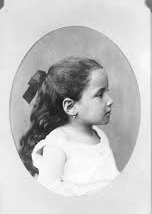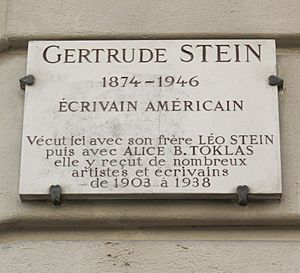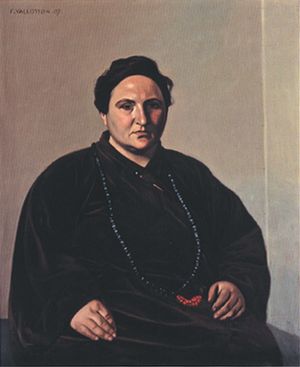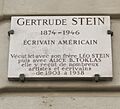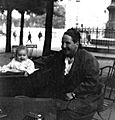Gertrude Stein facts for kids
Quick facts for kids
Gertrude Stein
|
|
|---|---|
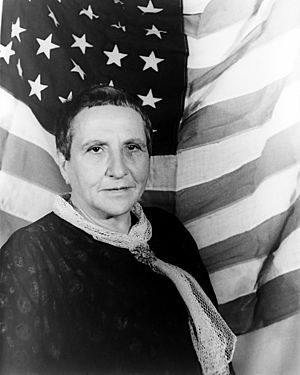
Portrait by Carl Van Vechten, 1935
|
|
| Born | February 3, 1874 Allegheny, Pennsylvania, U.S. |
| Died | July 27, 1946 (aged 72) Neuilly-sur-Seine, France |
| Resting place | Père Lachaise Cemetery |
| Occupation |
|
| Education | Harvard University (BA) Johns Hopkins University |
| Literary movement | Modernist literature |
| Partner | Alice Toklas |
| Signature | |
 |
|
Gertrude Stein (February 3, 1874 – July 27, 1946) was an American writer, poet, and art collector. She was born in Allegheny, Pennsylvania (now part of Pittsburgh). She grew up in Oakland, California. In 1903, Stein moved to Paris, France, and lived there for the rest of her life.
In Paris, she hosted a famous gathering place called a salon. Many important artists and writers of her time met there. These included Pablo Picasso, Ernest Hemingway, and Henri Matisse.
In 1933, Stein wrote a popular book called The Autobiography of Alice B. Toklas. It was written as if her close companion, Alice B. Toklas, was telling the story. This book made Gertrude Stein very famous. Two of her quotes are very well known: "Rose is a rose is a rose is a rose" and "there is no there there." The second quote is often about her childhood home in Oakland.
Her books also include Three Lives (1905–06) and Tender Buttons (1914). During World War II, Stein, who was Jewish, lived in Nazi-occupied France. She was able to stay safe and keep her art collection, possibly with help from a French official named Bernard Faÿ.
Contents
Early Life and Family

Gertrude Stein was born on February 3, 1874. She was the youngest of five children. Her parents, Daniel and Amelia Stein, were from a wealthy Jewish family. Her father was a successful businessman. In their home, they spoke both German and English. Gertrude's older siblings were Michael, Simon, Bertha, and Leo.
When Gertrude was three, her family moved to Vienna, Austria, and then to Paris. They had governesses and tutors to teach the children about European history and culture. In 1878, they returned to America and settled in Oakland, California. Her father became a director of the Market Street Railway in San Francisco.
Gertrude attended Sabbath school at the First Hebrew Congregation of Oakland. She had many good memories of California, especially from the four years they lived on a large property. She often explored with her brother, Leo, with whom she was very close. Gertrude found school in Oakland boring. Instead, she loved reading books by famous writers like Shakespeare and Wordsworth.
When Stein was 14, her mother died. Three years later, her father also passed away. Her oldest brother, Michael, who was 26, took over the family business. He moved his four siblings to San Francisco. In 1892, he arranged for Gertrude and her sister Bertha to live with their mother's family in Baltimore. There, she met Claribel and Etta Cone. The Cone sisters held Saturday evening gatherings, similar to the famous salon Gertrude would later host in Paris. They loved art and talking about it.
Education and Learning
College at Radcliffe
Stein went to Radcliffe College from 1893 to 1897. Radcliffe was connected to Harvard University at the time. She studied with the famous psychologist William James. With James's help, Stein did experiments on how people think and write when their attention is divided.
These experiments showed a type of writing called "stream of consciousness." This is a way of writing that shows a character's thoughts as they flow, without much order. Later, in 1934, a psychologist named B. F. Skinner thought Stein's poem Tender Buttons was an example of this. However, Stein herself said that writing is too complex to be truly "automatic."
At Radcliffe, she became lifelong friends with Mabel Foote Weeks. Their letters show a lot about Stein's life. In 1897, Stein studied biology at the Marine Biological Laboratory in Woods Hole, Massachusetts. She earned her Bachelor of Arts degree with honors from Radcliffe in 1898.
Medical School at Johns Hopkins
William James, her mentor at Radcliffe, encouraged Stein to go to medical school. He thought she was his "most brilliant woman student." Even though Stein wasn't very interested in medicine, she started at Johns Hopkins School of Medicine in 1897. In her fourth year, she lost interest and left without finishing her degree. She found medical school boring and spent many evenings walking and going to the opera instead of studying.
Being a woman in medicine was hard during Stein's time. The field was mostly for men, and women were not always welcomed. Stein wrote about this time in her life. She felt depressed and struggled to find her own identity. She realized she didn't fit the usual role for women. Some historians say her strong opinions about women in medicine caused problems with the male teachers. This contributed to her decision to leave.
Collecting Art
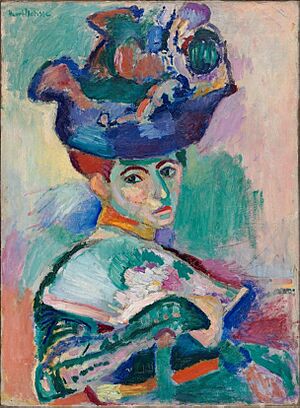
From 1903 to 1914, Gertrude lived with her brother Leo in a two-story apartment in Paris. It was near the Luxembourg Gardens on the Left Bank. Here, they started collecting art that became very famous and important.
Their art gallery space had large Renaissance-era furniture from Italy. The paintings covered the walls, reaching high up to the ceiling. At first, gaslight lit the art, but later, electric lights were added before World War I.
Leo Stein helped them connect with important people in the art world. This allowed the Stein collection to grow. In 1902, the art historian Bernard Berenson introduced Gertrude and Leo to Paul Cézanne and art dealer Ambroise Vollard. Vollard was a key contact in the Paris art world for both Leo and Gertrude.
Their joint art collection began in late 1904. They used money from their family trust to buy paintings. They bought Gauguin's Sunflowers, Cézanne's Bathers, and two paintings by Pierre-Auguste Renoir.
The art collection grew, and the walls at their home were always being rearranged for new art. In 1905, they bought Cézanne's Portrait of Mme Cézanne and Delacroix's Perseus and Andromeda. After an art show in October 1905, they bought Matisse's Woman with a Hat and Picasso's Young Girl with a Flower Basket. In 1906, Picasso finished his Portrait of Gertrude Stein, which stayed in her collection until she died.
Henry McBride, an art critic, helped make Stein famous in the United States. He wrote about her art collection and her importance in culture. He said her collection was "just about the most potent of any that I have ever heard of in history." McBride also noted that Gertrude "collected geniuses rather than masterpieces."
By early 1906, their studio had many paintings by Henri Manguin, Pierre Bonnard, Pablo Picasso, Paul Cézanne, Pierre-Auguste Renoir, Honoré Daumier, Henri Matisse, and Henri de Toulouse-Lautrec. Their collection showed the art from two major exhibitions in Paris. Gertrude's brother Michael and his wife Sarah also collected many Matisse paintings. Their friends, Claribel and Etta Cone, also collected art. They later gave their collection to the Baltimore Museum of Art.
Many artists visited the Stein salon, but not all of them had their paintings on the walls. Leo and Gertrude's collection mostly featured Renoir, Cézanne, Matisse, and Picasso. In April 1914, Leo moved to Italy, and the art collection was divided. Leo took sixteen Renoirs and a Picasso sketch of himself. He left the other Picassos and most of the Matisses with Gertrude. He also took a Cézanne painting of "5 apples." The split between them was not friendly, and they never saw each other again after a brief meeting in Paris after World War I.
After Leo left, Stein continued to collect Picasso's art, especially his Cubism work, which Leo did not like. By the time Gertrude died, her collection mostly had art by Picasso and Juan Gris.
Some people say that Gertrude Stein's personality often overshadowed her brother Leo's role in their art collection. However, Leo was a very skilled art expert. Alfred Barr Jr., who started New York's Museum of Modern Art, said that between 1905 and 1907, Leo was "possibly the most discerning connoisseur and collector of 20th-century painting in the world." After the art was divided, Gertrude focused on works by artists like Juan Gris and Francis Rose. In 1932, Stein said, "Painting now after its great period has come back to be a minor art."
The Stein Salon at 27 rue de Fleurus
The gatherings at the Stein home were very important for modern art and literature. They brought together many talented people. Regular visitors included Pablo Picasso, Ernest Hemingway, F. Scott Fitzgerald, Henri Matisse, and Georges Braque. Saturday evenings were set aside for these formal meetings so Stein could focus on her writing during the week.
Gertrude's companion, Alice B. Toklas, was the hostess for the wives and girlfriends of the artists. They would meet in a separate room. Alice once said, "I am a person acted upon, not a person who acts." When guests arrived, Alice would entertain their wives, who were considered "second-class citizens."
Gertrude said that the Saturday evening salons started because people came to see the paintings by Matisse and Cézanne. "Matisse brought people, everybody brought somebody, and they came at any time and it began to be a nuisance, and it was in this way that Saturday evenings began."
Among Picasso's friends who often visited were Fernande Olivier (an artist's model), Georges Braque (artist), André Derain (artist), Max Jacob (poet), and Guillaume Apollinaire (poet and art critic).
Hemingway often visited Stein's salon. They were close friends at first, and Hemingway looked up to Stein as a mentor. But their relationship became difficult later. Stein is often credited with coining the term "Lost Generation." This term describes people who grew up during or after World War I.
In 1938, Stein and Toklas moved from rue de Fleurus to another address in Paris. During much of World War II, they stayed in a rented house in Bilignin, France. This area was initially outside the direct German occupation zone.
Gertrude Stein's Writing Style
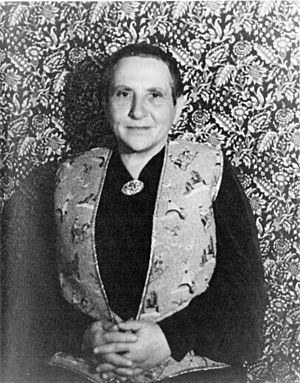
Gertrude Stein's writing can be put into three main types. First, there are her "hermetic" works, like The Making of Americans: The Hersland Family. These are harder to understand. Second, there are more popular books, like The Autobiography of Alice B. Toklas. Third, there are her speeches and easier autobiographical writings from later years, such as Brewsie and Willie.
Her books include novels, plays, stories, and poems. She wrote in a very unique, playful, and often repetitive way. Famous quotes include: "Rose is a rose is a rose is a rose" and "There is no there there" (about her childhood home in Oakland).
In 1933, a reader asked Stein to explain the "rose" quote. Alice B. Toklas replied for her, saying: "The device rose is a rose is a rose is a rose means just that. Miss Stein is unfortunately too busy herself to be able to tell you herself, but trusts that you will eventually come to understand that each and every word that she writes means exactly what she says, for she says very exactly what she means, and really nothing more, but, of course, nothing less."
These experimental writings, sometimes called "portraits," were meant to show "the excitingness of pure being." They are like literature's answer to art styles such as Cubism. Many of her experimental works, like Tender Buttons, have been seen by critics as a new way of using language. These works were liked by modern art critics but did not become popular right away. Stein did not see her work as "automatic writing," but as an "excess of consciousness."
Even though Stein collected cubist paintings, especially Picasso's, the biggest art influence on her writing was Paul Cézanne. He influenced her idea of "equality" in art. This means that every part of a painting or text is equally important. Stein said, "the important thing... is that you must have deep down as the deepest thing in you a sense of equality."
She used repetition a lot to describe the "bottom nature" of her characters. For example, in The Making of Americans, she repeats phrases like "As I was saying." Stein often used simple, old English words and avoided words with too many other meanings. Her writing does not judge, so readers can decide what to think and feel. Her work is often calm and brings things together.
Stein mostly used the present tense, which makes her writing feel like it's happening right now. This creates a continuous feeling. She also used "play" in her writing, giving readers the freedom to engage with the work actively. Her work is often funny and has many layers, allowing for different ways to understand it. In 1932, she wrote The Autobiography of Alice B. Toklas in an easier style to reach more people. This book became her first bestseller. Although it was titled as Alice's autobiography, it was actually Stein's own story.
Some of Stein's writings have been turned into music. For example, Virgil Thomson created operas from her works, like Four Saints in Three Acts.
Literary Journey
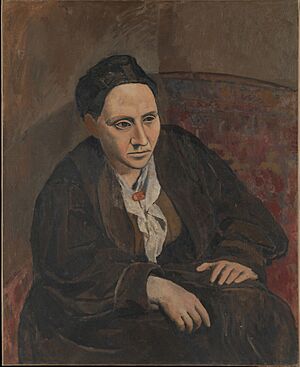
While living in Paris, Stein started sending her writings to publishers. Her first writings were mostly about her college experiences. Her first widely praised book was Three Lives. In 1911, Mildred Aldrich introduced Stein to Mabel Dodge Luhan. Mabel was a wealthy woman who helped promote Gertrude's work in the United States.
Mabel was very excited about Stein's long book The Makings of Americans. At a time when Stein had trouble getting her writing published, Mabel privately printed 300 copies of Portrait of Mabel Dodge at Villa Curonia. Mabel also helped with the publicity for the Armory Show in 1913. This was the first major modern art exhibition in America.
Mabel Dodge also wrote the first critical review of Stein's writing in America. She wrote that Stein's words were "exquisitely rhythmical and cadenced." She said that if you read it aloud, it's like "a kind of sensuous music." She suggested that readers should "forgetting to try to understand what they mean, one submits to their gradual charm."
Stein met Carl Van Vechten, a well-known critic and photographer, in Paris in 1913. They became lifelong friends. Van Vechten was a big supporter of Stein's writing in the United States. He became her American agent.
Touring America (1934–1935)
In October 1934, Gertrude Stein returned to America after 30 years. When she arrived in New York, many reporters were waiting. News about Stein was on the front page of almost every New York City newspaper. As she drove through Manhattan, she saw how famous she had become. An electric sign in Times Square announced, "Gertrude Stein Has Arrived."
Her six-month tour covered 191 days of travel. She visited 23 states and 37 cities. Stein saw Civil War battlefields, explored Chicago with detectives, watched a football game, and visited her childhood home in Oakland.
Stein gave public lectures during her tour. She prepared each one carefully, and audiences were limited to 500 people. She read from notes and answered questions at the end.
People had different opinions about her lectures. Some thought her audiences didn't understand her. Some even thought she had a speech problem that made her stutter. However, most people felt that Stein was a fascinating person. They were captivated by the "musicality of her language."
In Washington, D.C., Stein had tea with the President's wife, Eleanor Roosevelt. In Beverly Hills, California, she visited actor Charlie Chaplin. They reportedly talked about the future of movies. Stein left America in May 1935. She was now a celebrity, and Random House agreed to publish all her future books in America. The Chicago Daily Tribune wrote that "No writer in years has been so widely discussed, so much caricatured, so passionately championed."
Her Books
Q.E.D. (1903)
Stein finished Q.E.D., her first novel, in 1903. It was one of the earliest stories about a young woman discovering her feelings. It was inspired by events involving Stein and her friends while she was studying at Johns Hopkins University in Baltimore.
Fernhurst (1904)
In 1904, Stein started Fernhurst. This fictional story was about a complicated romantic situation. A biographer noted that in 1904, 30-year-old Gertrude "had evidently determined that the 'small hard reality' of her life would be writing."
Three Lives (1905–1906)
Stein said she was inspired to write Three Lives by a portrait of Cézanne's wife that was in her art collection. She felt this painting helped her develop her writing style. Stein described how the painting's careful structure influenced her repetitive sentences. She felt each phrase built up the characters, just as Cézanne built up his subjects. She started Three Lives in the spring of 1905 and finished it the next year.
The Making of Americans (1902–1911)
Gertrude Stein said she wrote The Making of Americans between 1906 and 1908. However, her biographer found that she actually started it in 1902 and finished in 1911. Stein compared her work to famous long novels like James Joyce's Ulysses. Her critics were not as excited about it. Most of the novel was written between 1903 and 1911. It was not widely available until 1924, when Ernest Hemingway encouraged its publication.
Stein's essays about Matisse and Picasso were published in 1912 in a special edition of Camera Work magazine. Stein said, "He was the first one that ever printed anything that I had done. And you can imagine what that meant to me or to any one."
Word Portraits (1908–1913)
Stein's descriptive essays, or "word portraits," began with a short piece about Alice B. Toklas. These early efforts included essays about Matisse and Picasso. They were later collected in books like Geography and Plays.
Her subjects included many people who later became famous. These portraits described what she saw at her Saturday gatherings in Paris. Some subjects were: "Ada" (Alice B. Toklas), "Two Women" (the Cone sisters), Miss Furr and Miss Skeene (Ethel Mars and Maud Hunt Squire), "Matisse" (Henri Matisse), "Picasso" (Pablo Picasso), and "Guillaume Apollinaire".
Tender Buttons (1912)
Tender Buttons is one of Stein's most famous "hermetic" works. It's a small book divided into three parts: "Food," "Objects," and "Rooms." Each part has short prose pieces. Its publication in 1914 caused a disagreement between Stein and Mabel Dodge Luhan. Mabel thought Stein chose the wrong publisher.
Mabel wrote to Gertrude, saying the publisher was "absolutely third rate." She worried it would make people think the "cubist movement" and Stein's work were "degenerate." Stein ignored Mabel's advice and published 1,000 copies of the book in 1914. Today, it is still in print.
In an interview, Stein said this work was "completely realistic." She explained, "I used to take objects on a table... and try to get the picture of it clear and separate in my mind and create a word relationship between the word and the things seen." This meant that even though her writing didn't directly show objects, the idea of them was still important.
The Autobiography of Alice B. Toklas (1933)
The publication of The Autobiography of Alice B. Toklas made Gertrude Stein famous in the United States almost overnight. While popular with the public, some people mentioned in the book were upset. Artists like Henri Matisse and Georges Braque felt Stein had misunderstood their work and the art community in Paris. Braque said she "entirely misunderstood cubism."
Four in America (1947)
This book was published after Stein's death in 1947. It was introduced by Thornton Wilder. In it, Stein created imaginary life stories for famous Americans. For example, she wrote about Ulysses S. Grant as a religious leader and George Washington as a novelist.
Alice B. Toklas

Gertrude Stein met her close companion, Alice B. Toklas, on September 8, 1907. It was Toklas's first day in Paris. They met at the apartment of Gertrude's brother, Michael Stein. When Toklas met Stein, she wrote about her: "She was a golden brown presence... She was dressed in a warm brown corduroy suit. She wore a large round coral brooch and when she talked... I thought her voice came from this brooch. It was unlike anyone else's voice—deep, full, velvety."
Soon after, Stein introduced Toklas to Pablo Picasso at his studio. He was working on his famous painting Les Demoiselles d'Avignon.
In 1908, they spent the summer in Italy. Toklas stayed with her travel companion, Harriet Lane Levy. Stein stayed with her brother Michael and his family. In 1910, Alice moved in with Gertrude and Leo. Their summer of 1908 is remembered in photos of them in Venice.
In early summer 1914, Stein bought three paintings by Juan Gris. Soon after, World War I began. Stein and Toklas had planned to visit England and Spain. They left Paris on July 6, 1914, and returned on October 17. They were visiting Alfred North Whitehead in England when Britain declared war on Germany. Their three-week trip turned into three months because of the war. They spent the first winter of the war in France.
With money from selling one of Stein's Matisse paintings, she and Toklas vacationed in Spain from May 1915 to spring 1916. While in Majorca, Spain, Gertrude kept in touch with Mildred Aldrich. Aldrich kept her updated on the war. Eventually, Gertrude and Alice decided to return to France to help with the war effort.
Toklas and Stein came back to Paris in June 1916. They bought a Ford car with help from friends in the United States. Gertrude learned to drive it. Gertrude and Alice then volunteered to drive supplies to French hospitals in their Ford. They named the car Auntie, "after Gertrude's aunt Pauline, 'who always behaved admirably in emergencies and behaved fairly well most times if she was flattered.'"
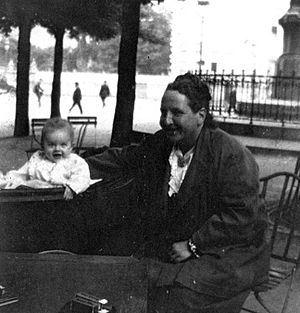
In the 1930s, Stein and Toklas became very famous after The Autobiography of Alice B. Toklas was published in 1933. They went on a long lecture tour in the United States. They also spent several summers in Bilignin, a town in eastern France. The two women loved their poodle named "Basket." After Gertrude's death, "Basket II" comforted Alice.
When World War II started, Stein and Toklas moved to a country home they had rented for many years in Bilignin. Both Stein and Alice were Jewish. They likely avoided harm because of their friendship with Bernard Faÿ. Faÿ was a French official who worked with the Vichy regime (the government that cooperated with Nazi Germany). He also had connections to the Gestapo (Nazi secret police). Another reason for their safety might have been that Stein was an American and a famous author.
In 1941, Stein agreed to translate speeches by Marshal Philippe Pétain into English. Pétain was the leader of the Vichy government. In her introduction, Stein compared Pétain to George Washington. She wrote that France respected Pétain for making a truce with Hitler. However, her translations were never published in the United States. Her publisher, Bennett Cerf, was shocked by what she had written.
It is hard to know how much Stein knew about the terrible events happening during the war. In 1944, Stein wrote that Pétain's policies were "really wonderful so simple so natural so extraordinary." This was the same year that Jewish children from the town where she lived were sent to Auschwitz. Stein had stopped translating Pétain's speeches three years earlier.
Stein was able to criticize the Japanese attack at Pearl Harbor. But she also seemed to accept Hitler as the conqueror of Europe. In a 1934 interview, Stein jokingly said that Hitler deserved the Nobel Peace Prize. She said he was "removing all elements of contest and struggle from Germany." She explained that by driving out Jews and others, he was creating "peace."
After the war, Stein said that to have world peace, Germans needed to be taught disobedience. Because of this, some people now think her 1934 interview was an ironic joke. It was a way for her to get attention and cause discussion.
It's not clear how much of Stein's actions during the war were just to keep herself safe. She was urged by American officials and friends to leave France when she could, but she chose not to. In an essay, she wrote that leaving would be "awfully uncomfortable and I am fussy about my food." Stein continued to praise Pétain even after the war, when he was sentenced to death for treason.
Some people have criticized Stein's actions during the war. Author Djuna Barnes said that Stein didn't seem truly worried about people's suffering. Others argue that some accounts of Stein's wartime activities have been unfair.
Death and Legacy
Gertrude Stein died on July 27, 1946, at age 72. She had surgery for stomach cancer in Neuilly-sur-Seine, near Paris. She was buried in Père Lachaise Cemetery in Paris. Later, Alice B. Toklas was buried next to her.
A famous story says that before her surgery, Stein asked Alice, "What is the answer?" When Alice said there was no answer, Stein replied, "Then, there is no question!" However, Alice B. Toklas gave different versions of this story. So, what Stein actually said remains a mystery.
Stein named writer and photographer Carl Van Vechten as the person in charge of her literary works after her death. He helped publish many of her writings that had not been printed yet.
Stein has been the subject of many artworks and performances.
- In Bryant Park, New York City, there is a bronze bust of Stein.
- In 2005, actor Jade Esteban Estrada played Stein in a musical.
- Loving Repeating is a musical based on Stein's writings.
- Stein is a character in Nick Bertozzi's 2007 graphic novel The Salon.
- In the 2011 film Midnight in Paris, Stein was played by Kathy Bates.
- She is mentioned in the Broadway musical Rent and in the 1935 film Top Hat.
- In 2014, Stein was honored in the Rainbow Honor Walk in San Francisco. This walk celebrates LGBTQ people who have made important contributions.
- The Gertrude Stein Society (GSS) at Johns Hopkins University School of Medicine is named after her. It is an organization for LGBTQ+ students.
Published Works
- Three Lives (1909)
- Tender Buttons: Objects, Food, Rooms (1914) online at Bartleby
- The Making of Americans: Being a History of a Family's Progress (written 1906–8, published 1925)
- Four Saints in Three Acts (libretto, 1929: music by Virgil Thomson, 1934)
- The Autobiography of Alice B. Toklas (1933a)
- Everybody's Autobiography (1937)
- Doctor Faustus Lights the Lights (1938)
- Paris France (1940)
- Ida A Novel (1941)
- Wars I Have Seen (1945a)
- Brewsie and Willie (1946b)
- The Mother of Us All (libretto, 1946c: music by Virgil Thompson 1947)
- Four in America (1947)
- The Things as They Are (written as Q.E.D. in 1903, published 1950)
Images for kids
-
Portrait by Carl Van Vechten, 1935
-
Stein's birthplace and childhood home in Allegheny West
-
Henri Matisse's, Woman with a Hat, 1905
-
Carl Van Vechten, Portrait of Gertrude Stein, 1934
-
Pablo Picasso, Portrait of Gertrude Stein, 1906, Metropolitan Museum of Art, New York
-
Alice B. Toklas and Gertrude Stein (1922) by Man Ray
-
Stein with Ernest Hemingway's son, Jack Hemingway, in 1924
See also
 In Spanish: Gertrude Stein para niños
In Spanish: Gertrude Stein para niños


